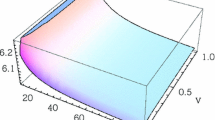Abstract
Evolution of cooperation is still a puzzle in evolutionary and socio biology. Based on the asymmetric interactions in a dominance hierarchy system, a simple theoretical framework is developed to reveal the effect of “induced cooperation” (i.e., the cooperative behavior of subordinate individuals to dominant individuals) on the evolution of cooperation. Extending the classic Prisoner’s Dilemma (PD) game, we define the concept of the defection cost of subordinate individuals to measure the effect of induced cooperation, i.e., a subordinate defector will incur a cost when it plays against a dominant defector. The analysis of the repeated PD game with linear dominance hierarchy and with cyclic dominance hierarchy shows clearly that induced cooperation of subordinate individuals may lead to a population’s full cooperation, and that the coexistence of cooperation and defection in a population with hierarchy dominance is possible. Our results are the first step to develop a new theoretical approach for understanding the emergence of cooperation; namely, that induced cooperation is one of the most important forces driving the evolution of cooperation as pointed out by May (in May R, McLean A (eds) Theoretical ecology 3rd edn., (2007)).




Similar content being viewed by others
References
Akcay E, Meirowitz A, Ramsay KW, Levin SA (2012) Evolution of cooperation and skew under imperfect information. Proc Natl Acad Sci USA 109:14936–14941
Amman E, Possajennikov A (2009) On the stability of evolutionary dynamics dynamics in games with incomplete information. Math Soc Sci 58:310–321
Axelrod RM, Hamilton WD (1981) The evolution of cooperaton. Science 1981(211):1390–1396
Axelrod RM (1984) The evolution of cooperation. Basic Books, New York
Bernestein IS, Sharpe LG (1966) Social roles in a rhesus monkey group. Behaviour 26:91–105
Cressman R (2003) Evolutionary dynamics and extensive form games. MIT Press, Cambridge
Eisenberg JE, Kuehn RE (1966) The behavior of Ateles geoffroyi and related species. Smithsonian Misc Collect 151, pp. iv + 188
Frank SA (1998) Foundations of social evolution. Princeton University Press, Princeton
Gaunersdorfer A, Hofbauer J (1995) Fictitious play, shapley polygons, and the replicator equation. Games Econ Behav 11:279–303
Hamilton WD (1964) The genetic evolution of social behaviour I. J Theor Biol 7:1–16
Hamilton WD (1964) The genetic evolution of social behaviour II. J Theor Biol 7:17–32
Hamilton WD (1988) Narrow Roads of Gene Land: the collected papers of W.D. Hamilton, Volume 1: Evolution of Social Behaviour. Oxford University Press, New York
Hammerstein P (1981) The role of asymmetries in animal contests. Anim Behav 29:578–581
Hofbauer J, Sigmund K (1998) Evolutionary games and population dynamics. Cambridge University Press, Cambridge
Jordan JS (1993) Three problems in learning mixed-strategy Nash equilibrium. Games Econ Behav 5:368–386
Krebs JR, Davies NB (1993) An introduction to behaviour ecology. Blackwell Publishing, Oxford
May R (2007) Unanswered questions and why they matter. In: May R, McLean A (eds) Theoretical ecology, 3rd edn. Oxford Press, New York, pp 214–215
McNamara JM, Wilson EMT, Houston AI (2006) Is it better to give information, receive it, or be ignorant in a two-player game? Behav Ecol 17:441–451
Mesterton-Gibbons M, Sherratt TN (2011) Information, variance and cooperation: minimal models. Dyn Games Appl 1:419–439
Nonacs P, Hager R (2011) The past, present and future of reproductive skew theory. Biol Rev Camb Philos Soc 86:271–298
Nowak MA (2006) Evolutionary dynamics. The Belknap Press of Harvard University Press, Cambridge
Nowak MA (2006) Five rules for the evolution of cooperation. Science 314:1560–1563
Nowak MA (2011) Super cooperators. Free Press, New York
Nowak MA, Sigmund K (1998) Evolution of indirect reciprocity by image scoring. Nature 393:573–577
Nowak MA, Sigmund K (1998) The dynamics of indirect reciprocity. J Theor Biol 194:561–571
Nowak MA, Sigmund K (2007) How populations cohere: five rules for cooperation. In: May R, McLean A (eds) Theoretical ecology, 3rd edn. Oxford Press, Oxford
Ohtsuki H, Hauert C, Liberman E, Nowak M (2006) A simple rule for the evolution of cooperation on graphs and social networks. Nature 441:502–505
Reeve HK, Emlen ST (2000) Reproductive skew and group size: an N-person staying incentive model. Behav Ecol 11:640–647
Sandholm WD (2010) Population games and evolutionary dynamics. MIT Press, Cambridge
Smith Maynard J (1982) Evolution and the theory of games. Cambridge University Press, Cambridge
Tokuda K, Jensen GD (1968) The leader’s role in controlling aggressive behavior in a monkey group. Primates 9:319–322
Traulsen A, Nowak MA (2006) Evolution of cooperation by multi-level selection. Proc Natl Acad Sci USA 103:10952–10955
Trivers RL (1971) The evolution of reciprocal altruism. Q Rev Biol 46:35–37
Trubenov B, Hager R (2012) Reproductive skew theory. Wiley, Chichester
Ubeda F, Duenez-Guzman EA (2011) Power and corruption. Evolution 65:1127–1139
van Damme E, Hurkens S (1999) Endogenous Stackelberg leadership. Games Econ Behav 28:105–129
van Veelen M (2007) Hamilton’s missing link. J Theor Biol 246:551–554
von Stengel B (2010) Follower payoffs in symmetric duopoly games. Games Econ Behav 69:512–516
Walters JR, Seyfarth RM (1987) Conflict and cooperation. In: Smuts BB, Cheney DL, Seyfarth RM, Wrangham RW, Struhsaker T (eds) Primate societies. University of Chicago Press, Chicago, pp 306–317
Wilson EO (1975) Sociobiology: the new synthesis. Belknap Press, Harvard
Acknowledgments
Support from the Natural Sciences and Engineering Research Council of Canada and from National Natural Science Foundation of China (Grant No. 31270439) is gratefully acknowledged. Referee suggestions for improvements are also appreciated.
Author information
Authors and Affiliations
Corresponding author
Electronic supplementary material
Below is the link to the electronic supplementary material.
Rights and permissions
About this article
Cite this article
Tao, Y., Xu, JJ., Li, C. et al. Dominance Hierarchies Induce a Population’s Full Cooperation. Dyn Games Appl 4, 432–447 (2014). https://doi.org/10.1007/s13235-014-0126-y
Published:
Issue Date:
DOI: https://doi.org/10.1007/s13235-014-0126-y




